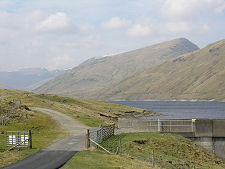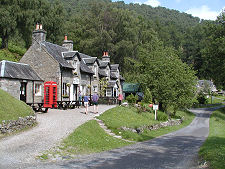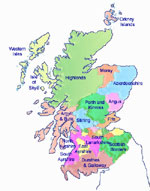Welcome to Glenlyon Scotland
 Glen
Lyon is little known, and less visited, and it is only when you seek it
out on a map that you begin to realise just how significant a presence
it is in the central Highlands. The glen extends for some 25 miles from
the pretty village of Fortingall in the east to the head of Loch Lyon
in the west. Glen
Lyon is little known, and less visited, and it is only when you seek it
out on a map that you begin to realise just how significant a presence
it is in the central Highlands. The glen extends for some 25 miles from
the pretty village of Fortingall in the east to the head of Loch Lyon
in the west.
Starting your exploration of Glen Lyon in Fortingall, which is home to
some highly unusual thatched cottages, an excellent hotel, an attractive
church, and the ancient Fortingall Yew, believed to be 5,000 years old
and quite possibly the oldest living thing on earth. It has also been
claimed that Fortingall was the birthplace of Pontius Pilate.
At the west end of the village of Fortingall is Glenlyon House, parts
of which date back to 1694. A little to its west, the River Lyon emerges
from the steep sided rocky jaws of Glen Lyon itself. The road through
the glen is single track throughout, though the first two miles through
the glen are the most demanding as the road follows the twists and turns
of the fast flowing and tightly confined river. Thereafter the glen opens
out and sight lines on the road improve, and the further west you go the
more open it becomes. You also tend to find that the further west you
go the less traffic you encounter.
Accommodation in and around Glenlyon
Price Guide - per person based on sharing room:  under $40 -
under $40 -  $41
- 70 - $41
- 70 -  more than
$70 more than
$70
As the glen begins to open out, keep a lookout for the arch of a packhorse
bridge crossing a tributary below a waterfall on the south bank of the
River Lyon. This is locally known as the Roman Bridge, though actually
seems to date back to the 1600s or 1700s. A little further on, and equally
elusive if you are not observant, are the ruins of Carnbane Castle. These
stand on top of a spur of high ground on the north side of the river above
the road. The castle seems to have been a fortified hall-house dating
back to the 1500s. It was built by Red Duncan Campbell the Hospitable,
who was not quite so hospitable that he overlooked the inclusion of gunloops
in the design. The castle was burned down during a raid by cattle thieves,
and has stood as a ruin ever since.



The tiny hamlet of Invervar is best known as the starting point for the
walk round the "Glen Lyon Horseshoe", a circuit of four Munros,
or individual mountains over 3000ft high, to the north: Carn Gorm, Meall
Garbh, Carn Mairg and Meall na Aighean. Assuming you are driving rather
than hillwalking, the next highlight along the glen is St Adamnan's Cross
(or St Adomnán's Cross) on top of an embankment on the left hand
side of the road just before you reach the farmstead at Camusvrachan.
This is a stone which leans over to one side and carries a cross on two
faces. It is named after Adomnán, Abbot of Iona from 679 to 704.
There are suggestions that Adomnán visited Glen Lyon on a number
of occasions en route from Iona to Pictish Atholl, and the cross is one
of a number of objects named after or dedicated to him in the area.
In Glenlyon Church at Innerwick, you can see another, St Adomnán's
Bell, believed to date back to the 700s and found in the churchyard of
the ruined St Brandon's Chapel in the glen. Not far from Glenlyon Church
is the Glen Lyon War Memorial, next to the road. A little further is Bridge
of Balgie, home to the glen's post office and a tea room, as well as a
gallery. From Bridge of Balgie an adventurous single track road provides
an alternative route into or out of the glen as it climbs to a height
of 1800ft over the flank of Ben Lawers before descending to Loch Tay,
east of Killin. This minor road is not kept open in winter conditions.
If you continue along Glen Lyon, you find it becomes much more open west
of Bridge of Balgie. It is worth looking out for the spectacularly white
Meggernie Castle, close to the river south of the road: but you only catch
a brief glimpse from the main road and closer approaches are deterred
by "private" signs. Meggernie Castle was the traditional home
of the Campbells of Glen Lyon, and lairds included Captain Robert Campbell,
who led the government troops who committed the Glencoe Massacre.
A branch in the road beyond Meggernie Castle allows you to turn north
west towards Loch an Diamh and its surrounding Munros, including Meall
Buidhe. The alternative is to press on into the ever wider spaces of the
western end of Glen Lyon. En route you pass power stations at Stronuich
and Cashlie and the remains of a series of homesteads. A cairn on a hill
to the right of the road remembers (a different) Robert Campbell, noted
for his exploration of north west Canada.
As you approach Pubil and Lubreoch, the glen is increasingly dominated
by the massive Lubreoch Dam, whose construction in the 1950s created the
five mile long Loch Lyon as part of a wider hydro-electric scheme. The
head of Glen Lyon is an intriguing place, with the far end of the loch
being only four miles from Bridge of Orchy and the West Highland Railway.
When we first produced this page we noted that, apart from the road south
from Bridge of Balgie, Glen Lyon was a cul de sac. Most maps continue
to show it as such, but it is worth knowing that there is a single track
tarmac road leading south from Lubreoch at the east end of Loch Lyon to
the head of Glen Lochay. This is apparently open for public use. It climbs
to a high point of nearly 1700ft and is unlikely to be passable in winter
conditions.
|
![]() Email enquiries & reservations: bookscotland@madbookings.com
Email enquiries & reservations: bookscotland@madbookings.com
 Glen
Lyon is little known, and less visited, and it is only when you seek it
out on a map that you begin to realise just how significant a presence
it is in the central Highlands. The glen extends for some 25 miles from
the pretty village of Fortingall in the east to the head of Loch Lyon
in the west.
Glen
Lyon is little known, and less visited, and it is only when you seek it
out on a map that you begin to realise just how significant a presence
it is in the central Highlands. The glen extends for some 25 miles from
the pretty village of Fortingall in the east to the head of Loch Lyon
in the west.


